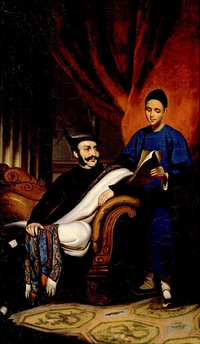Sir Jamsetjee Jeejebhoy
| Sir Jamsetjee Jejeebhoy, Bt | |
|---|---|

Jejeebhoy and his Chinese secretary (portrait by George Chinnery)
|
|
| Born |
15 July 1783 Bombay, India |
| Died | 14 April 1859 (aged 75) Bombay, India |
| Occupation | Merchandiser, business magnate |
Sir Jamsetjee Jejeebhoy, 1st Baronet (15 July 1783 – 14 April 1859), also spelt Jeejeebhoy or Jeejebhoy, was a Parsi-Indian merchant and philanthropist. He is more historically notable for making a huge fortune on the opium trade to China.
Jejeebhoy was born in Bombay (now Mumbai) in 1783, of Merwanjee Mackjee Jejeebhoy and Jeevibai Cowasjee Jejeebhoy, a textile merchant from Olpad, Gujarat, who migrated to Bombay in the 1770s. His parents died in 1799 after which he was brought up by his maternal uncle Framjee Nasserwanjee Battliwala. At the age of sixteen, having had little formal education, he made his first visit to Calcutta and then began his first voyage to China to trade in cotton and opium.
Jejeebhoy's second voyage to China was made in a ship of the East India Company's fleet. Under the command of Sir Nathaniel Dance, this ship drove off a French squadron under Rear-Admiral Charles-Alexandre Léon Durand Linois in the Battle of Pulo Aura.
On Jejeebhoy's fourth voyage to China, the Indiaman in which he sailed was forced to surrender to the French, by whom he was carried as a prisoner to the Cape of Good Hope, then a neutral Dutch possession. After much delay and great difficulty, Jejeebhoy made his way to Calcutta in a Danish ship. Undaunted, Jejeebhoy undertook another voyage to China which was more successful than any of his previous journeys.
By this time Jejeebhoy had fairly established his reputation as an enterprising merchant possessed of considerable wealth. In 1803, he married his maternal uncle's daughter Avabai (d.1870) and settled in Bombay, where he directed his commercial operations on an extended scale. Around this time, he changed his name from "Jamshed" to "Jamsetjee" to sound similar to names of the Gujarati community. In 1814, his co-operation with the British East India company had yielded him sufficient profits to purchase his first ship, the Good Success, and he gradually added another six ships to this, usually carrying primarily opium and a little cotton to China. By 1836, Jejeebhoy's firm was large enough to employ his three sons and other relatives, and he had amassed what at that period of Indian mercantile history was regarded as fabulous wealth.
...
Wikipedia
